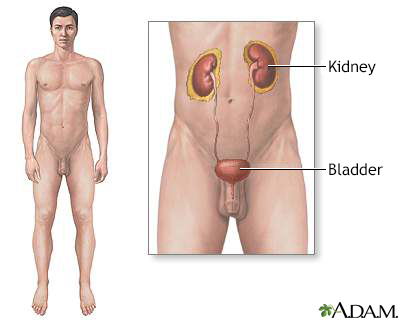Pregnancy SmartSiteTM
Phenacetin nephritis; Nephropathy - analgesic; Nephropathy - NSAID DefinitionAnalgesic nephropathy involves damage to one or both kidneys caused by overexposure to mixtures of medicines, especially over-the-counter pain medicines (analgesics). CausesAnalgesic nephropathy involves damage within the internal structures of the kidney. It is caused by long-term use of analgesics (pain medicines), especially over-the-counter (OTC) medicines that contain phenacetin or acetaminophen, and nonsteroidal anti-inflammatory drugs (NSAIDs), such as aspirin, ibuprofen, or naproxen. This condition frequently occurs as a result of self-medicating, often for some type of chronic pain such as headache or arthritis. Risk factors include:
SymptomsThere may be no symptoms in the beginning. Over time, as the kidneys are injured by the medicine, symptoms of kidney disease will develop, including:
Exams and TestsYour health care provider will examine you and ask about your symptoms. During the exam, your provider may find:
Tests that may be done include:
TreatmentThe primary goals of treatment are to prevent further damage of the kidneys and to treat kidney failure. Your provider may tell you to stop taking all suspect painkillers, particularly OTC medicines. To treat kidney failure, your provider may suggest diet changes and fluid restriction. Eventually, dialysis or a kidney transplant may be needed. Counseling may help you develop alternative methods of controlling chronic pain. Outlook (Prognosis)The damage to the kidney may be acute and temporary, or chronic and long term. Possible ComplicationsComplications that may result from analgesic nephropathy include:
When to Contact a Medical ProfessionalContact your provider if you have any of the following:
PreventionFollow your provider's instructions when using medicines, including OTCs. Do not take more than the recommended dose without asking your provider. ReferencesAronson JK. Paracetamol (acetaminophen) and combinations. In: Aronson JK, eds. Meyler's Side Effects of Drugs. 16th ed. Waltham, MA: Elsevier; 2016:474-493. Parazella MA, Rosner MH. Tubulointerstitial diseases. In: Yu ASL, Chertow GM, Luyckx VA, Marsden PA, Skorecki K, Taal MW, eds. Brenner and Rector's The Kidney. 11th ed. Philadelphia, PA: Elsevier; 2020:chap 35. Segal MS, Yu X. Herbal and over-the-counter medicines and the kidney. In: Johnson RJ,, Floege J, Tonelli M, eds. Comprehensive Clinical Nephrology. 7th ed. Philadelphia, PA: Elsevier; 2024:chap 79. | |
| |
Review Date: 8/28/2023 Reviewed By: Walead Latif, MD, Nephrologist and Clinical Associate Professor, Rutgers Medical School, Newark, NJ. Review provided by VeriMed Healthcare Network. Also reviewed by David C. Dugdale, MD, Medical Director, Brenda Conaway, Editorial Director, and the A.D.A.M. Editorial team. The information provided herein should not be used during any medical emergency or for the diagnosis or treatment of any medical condition. A licensed medical professional should be consulted for diagnosis and treatment of any and all medical conditions. Links to other sites are provided for information only -- they do not constitute endorsements of those other sites. No warranty of any kind, either expressed or implied, is made as to the accuracy, reliability, timeliness, or correctness of any translations made by a third-party service of the information provided herein into any other language. © 1997- A.D.A.M., a business unit of Ebix, Inc. Any duplication or distribution of the information contained herein is strictly prohibited. | |

 Male urinary syste
Male urinary syste
